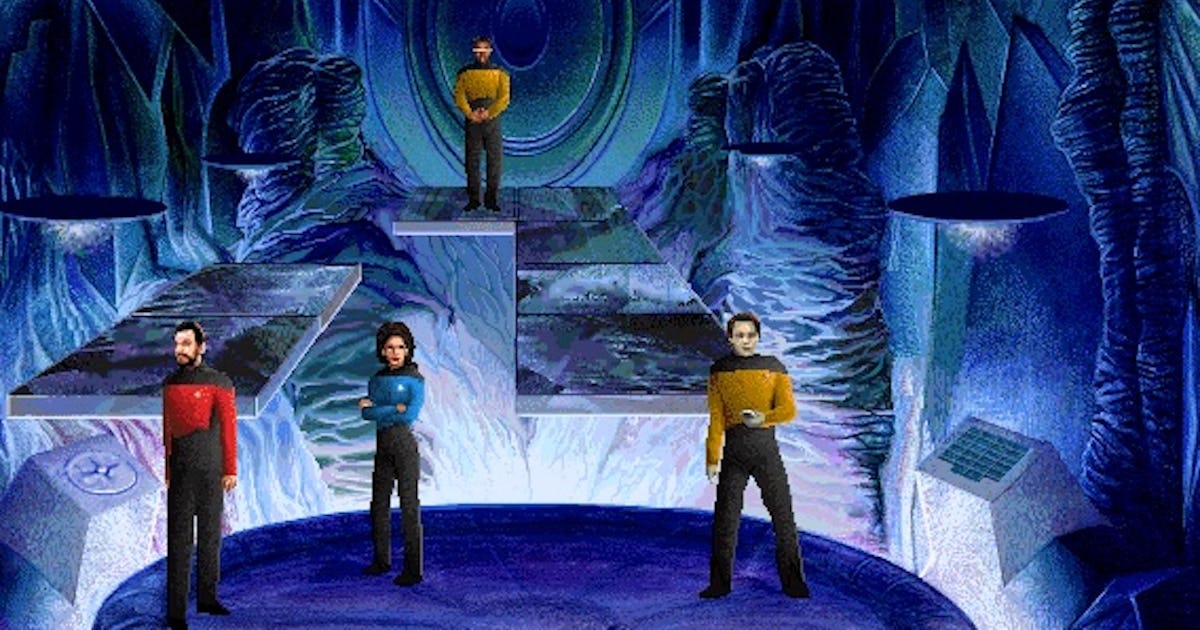When Star Trek: The Next Generation was at its peak in the early 1990s, it wasn’t uncommon for the Boomer Trekkies from the 1960s and 1970s to complain. Kirk vs. Picard debates were all too common back then, with one of the most common complaints being that the Enterprise-D crew sat around and talked way more than the classic crew ever did. How can you hope to have a great action-adventure sci-fi story if people are discussing the minutia of alien artifacts or how to disrupt a tractor beam? Well, it turns out, not only did the contemplative and talky nature of TNG make it a wonderful show, but in 1995, these defining narrative features also made it a wonderful game.
On June 30, 1995, developer Spectrum HoloByte released the game Star Trek: The Next Generation — A Final Unity for DOS and Mac platforms of the time. This was a full year after The Next Generation aired its last episode, “All Good Things…” and almost a year after the first feature film, Generations, was in theaters. So, at the time, A Final Unity represented a kind of instant nostalgia for TNG fans, who were rewarded with a kind of Valentine to the fandom. A Final Unity features the entire TNG cast reprising their voice roles throughout the game, which isn’t just for wonky cut-scenes, but also every aspect of gameplay.
A Final Unity had the player making nealry every major decision in the story.
Paramount/Spectrum HoloByte
Through patient and deliberate gameplay, A Final Unity achieves something that shouldn’t really even be possible in a video game, and certainly not 30 years ago. It actually recreates the feeling of living inside an episode of TNG, complete with pacing that feels almost intentionally slow at times. Very often, as Captain Picard, the player will need to talk to all members of the bridge crew to get their advice and input.
These decisions, as well as calling Starfleet and having long chats with exiled alien scientists, are the meat and potatoes of the game. A Final Unity knows that good Star Trek stories come chatting a lot on the bridge of the Enterprise before springing into action. Yes, you tango with Garidian Warbird (a sort of faux-Romulan ship) in the early moments of the game, but you can mostly delegate the phasering and destruction to Worf. The advice you get from Worf, Riker, or Troi is all more interesting and more fun than any pew-pew action.
The story of A Final Unity had input from Naren Shankar, who wrote for The Next Generation, and at the time the game came out, had also written for Deep Space Nine and Voyager. In the 21st century, science fiction fans probably think of Shankar as the showrunner of The Expanse, and some of the interstellar mystery in A Final Unity isn’t totally out of place with that series at all. But, more than anything, A Final Unity does feel like a very long, legitimate, and lost episode of The Next Generation.
Today, Star Trek fans don’t have anything near this immersive, nor authentic. The contemporary mobile game Star Trek Fleet Command is all about blowing up other starships, while the more peaceful Star Trek Timelines allows you to roleplay various missions, but (with the exception of John de Lancie) has little new bespoke dialogue from Star Trek actors. Playing A Final Unity online now is possible, including sites like Freebie Games. Once you start replaying the game, you’ll instantly be sucked into the story, assuming you have even a passing intersting in The Next Generation.
So not only does A Final Unity hold up extremely well after thirty years, it also represents something that tie-in video games have seemingly lost. In 1995, it was possible to have a slow-paced, dialogue-heavy, point-and-click game. The slowness was a feature, not a bug, and if a new developer were to make a modern Star Trek game, A Final Unity is the gold-pressed latinum standard, for now, and maybe, always.
Source link
Video Games,Star Trek,star-trek,entertainment,gaming,homepage,hp-latest,tv,adex-light-bid



Average Rating